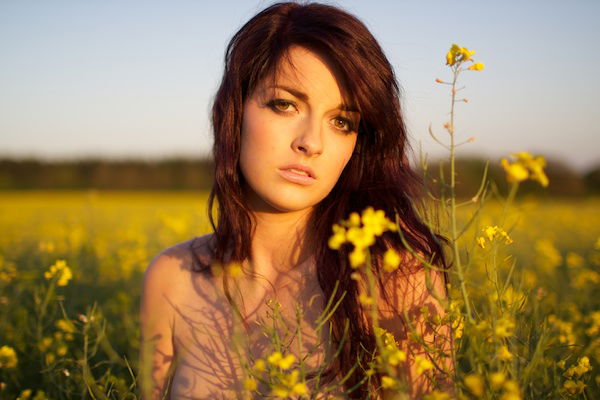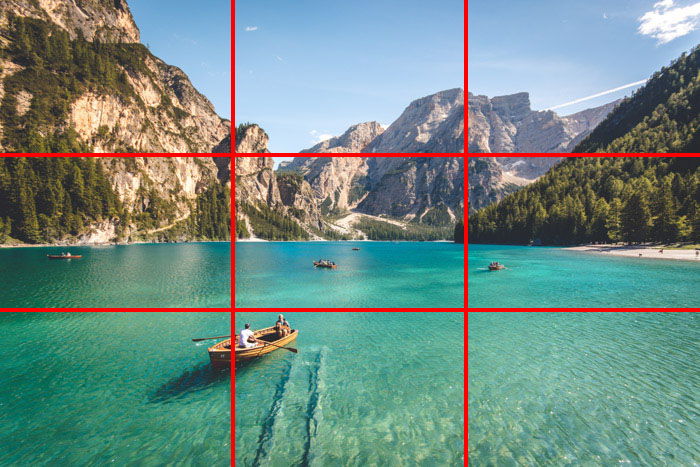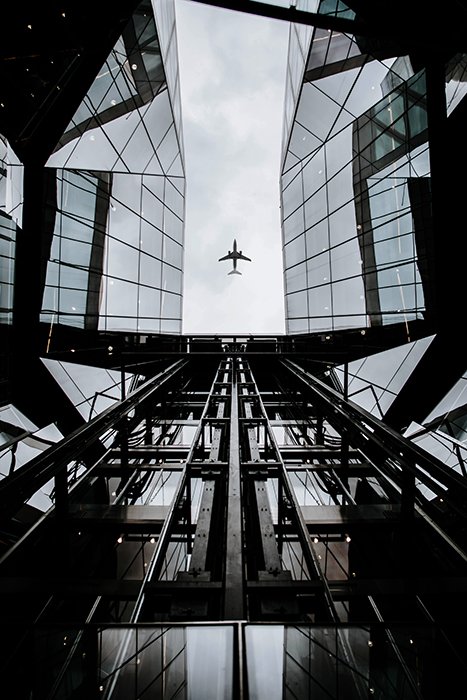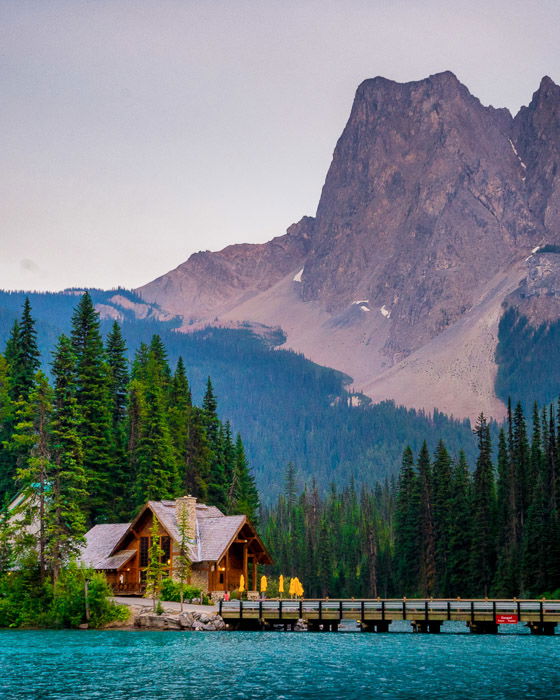Composition is one of the fundamental ideas behind all art, whether it’s photography, painting, or graphic design. It’s the concept that describes how every element in your piece fits together as a whole.
But photography composition can be confusing and difficult without the right knowledge. And some composition techniques are better than others for certain photos. So how do you know which technique to use and when?
Read our complete guide here on everything you need about photography composition.

What Is Photography Composition?
Beginner photographers tend to worry about their gear. They think about the best cameras, lenses, lighting setups, posing their models, etc. Some beginners think about everything but composition. And yet, this is what brings together their image.
The photographic composition is what separates a well-taken image from a hasty snapshot. There are specific composition “rules” that you need to learn and consider when capturing an image or a scene.
With practice, these rules will become second nature. You won’t even have to think about composition. You’ll just shoot. But for now, read through our guide, take notes, and then go out there and apply these rules of composition.

The Basic Composition Rules of Photography
How to Use Eyelines to Influence Your Viewers
Any photographs with people in them will have eyelines. Unless you love the “guillotine composition” (a portrait with the head outside of the frame), you’ll have eyelines.
Eyelines are where your subject is looking. They could be towards the camera and the viewer, to another person or subject in the frame, or to the outside world. Some lead you out of the frame.
Eyes in an image are our go-to starting place. We follow their eyeline to see what they’re focusing on. The article linked above will give you all the information you need to know to utilize eyelines in your photography.

How to Choose Horizon Placement in Photography Composition
The horizon is important. It is the place where land and sky always meet. But where do you put this dominant line into your frame?
Well, many people will divide an image 50/50, placing the line in the center of the image. This doesn’t place importance on either half. It might be symmetrical, but it doesn’t give you anything other than the feeling of two images stuck together.
It’s important to know what’s more interesting, the sky or the Earth. Then you have to decide which is more important for your image and compose accordingly.
Read our article linked above to better understand the perfect placement of the horizon in your photo.
What Is the Rule of Thirds? (And How to Use It in Photos!)
The rule of thirds is among the most essential rules of composition in photography. When you start taking photos, you get to know this rule very quickly.
The rule of thirds divides the frame with two vertical and two horizontal lines. The four lines intersect at four points. To create a visually appealing photo, you should place your points of interest on or near these spots.
The article linked above will tell you everything you need to know about using the rule of thirds in photography.

Making the Most of Lines, Shapes, and Form
After taking many photos, you will find every shot has lines, shapes, and forms. Some images will have more than others. As photographers looking to improve our composition, we can use these elements to our advantage.
Lines are the edges of a subject or an object that show the boundaries between two or more different items. They also serve to lead the viewer’s eyes.
The shape is what gives the object character. It might be two-dimensional on paper, but you can use form to make it look three-dimensional.
The article linked above will tell you everything you need to know about using these design elements. They’re great for adding artistic elements to your photography composition.

How to Use Triangles in Photography Composition
Triangles are very important shapes. Look at the pyramids to see a display of their stability, strength, and power. If you look closely enough, you will find them in almost everything you see and photograph.
They are powerful as they combine the techniques of lines and paths. They give the viewer the impression of stability.
These triangles can encompass the leading lines rule. You can use them to point towards a part of the image with interest.
Implied triangles are common in photography. These lines make up an implied triangle rather than an exact triangle.
The article linked above has everything you need to know about using triangles in your composition.
Using Visual Weight in Your Photos
The visual weight of an image is more than the sum of its parts. Every subject or object in your frame has a visual weight. By understanding the weights of objects, you can better position them in your photo.
For example, eyes provide very strong visual weights in images. They tend to be where we place the most amount of our attention. If you want the viewer to focus on the person’s face, reducing the weight given to the eyes might limit the impact on the viewer.
The article linked above tells you everything you need to know about visual weight in photography.
Balance in Photo Composition
Balancing an image is a great start to a successful composition. Symmetry can be an effective way to show a balanced scene. This can be right to left, which is common in architectural scenes. Or it could be top to bottom, which you’ll often see in photos with reflections.
Symmetry and balane are powerful techniques and draw your attention to the image. The placement, size, and visual weight of the objects in the scene are important in creating a balance.
However, the opposite can also work. Unbalancing a scene on purpose can cause tension. It will have your viewer searching the image for understanding or meaning.
The article linked above tells you everything you need to know about balancing your images.
Emphasize Your Subject With a Single-Point Composition
A great place to start with composition is focusing on capturing and emphasizing one main subject. This helps you and your viewer forget about any distracting or complex arrangements.
A single point can break up a plain scene and add interest to an otherwise uninteresting area. What you want from having a single point depends on your vision and what is available.
Photographing a portrait is a prime example of this single-point composition. It can even work alongside the rule of thirds, placing the subject’s face at one of the intersecting points.
The article linked above has everything you need to know about using a single-point composition in your photos.
How to Use Focal Points in Photography Composition
Choosing the right focus point is crucial for composition in photography. The right focus point helps isolate your subject. This is helped further by keeping the rest of the image blurred.
Before experimenting with the focus points to improve your photography composition, you need to understand the technical part.
You have to learn how to select a focus point with your camera. You also need to decide if you want to shoot in Manual mode or in one of the autofocus modes.
Read the article linked above to learn how to use focus points in photography composition.

Figure-to-Ground Photography Composition
Figure-to-ground is a form of composition. This is a great technique to separate your subject from its background. We can use it to differentiate between two parts of the image with contrasting colors. A silhouette is a perfect example.
This type of composition takes an image of a subject in a way that gives them the most attention. If you were to photograph a white dog in the snow, it would be difficult for the viewer to focus on the animal. This is because the foreground and background are white.
On the other hand, a great example of figure-to-ground composition would be photographing a black dog in the snow. The sharp contrast is what makes this a figure-to-ground composition.
The article linked above has everything you need to know about figure-to-ground composition.
Use the Golden Ratio to Add Interest to Your Photos
The golden ratio is a composition guide. It’s sometimes called the Fibonacci spiral, golden spiral, phi grid, or golden mean. It helps lead the viewer’s eye through the entire photo, leading to more captivating images.
This is based on the spirals seen in nature, from DNA strands to waves crashing on the beach. The ratio is 1.618:1 and creates an outward spiral effect.
The golden spiral suggests placing the subject on the smallest box in the center of the spiral, then placing other prominent areas of the image on the remaining curve. It will lead the viewer’s eye through the image.
The article linked above tells you how to create images that fit this interesting compositional rule.

How to Use the Golden Triangle in Photography Composition
There is another “golden” rule when it comes to composition in photography: the golden triangle. It is a variant of the rule of thirds.
Instead of using vertical and horizontal lines, you use diagonal lines to divide your frame. This adds a more dynamic feel to your photo.
As the name suggests, you use triangles instead of rectangular boxes to place important elements in the frame. The golden triangle is an excellent composition rule for everything from portraits to mountain ranges.
The article linked above has everything you need to know about using the golden triangle in photography.

Creative Tips for Using Repetition and Pattern in Photography
Once you start looking for patterns, repetition, and rhythm, you’ll start seeing them everywhere. Everything has a pattern if you are close enough or far away enough to see them.
The best street photographers are good at recognizing (and often breaking) patterns. They can be both manmade and natural.
Architectural photography is an excellent genre for finding geometrically perfect patterns. Finding the patterns and showing them off is a challenge in itself.
Read our article linked above on how to find and capture those defining designs.

Use Natural Frames for Better Photo Composition
Natural framing is a valuable compositional tool in any photographer’s toolkit. It directs the viewer’s eye to the point of interest in a photograph.
Natural frames also add narrative and depth to an image, holding a viewer’s attention for longer. Photos already have a frame—the edges of the photo. And including a natural frame within the photo’s edges adds more interest to your composition.
This composition technique brings your attention to the inside of the frame. This is a good spot to put the most interesting subjects in the photo.
Read our article linked above for all our top tips on natural framing.

How to Fill the Frame for Better Photography Composition
In photography, the “frame” is the edges of the scene that your camera captures. To “fill the frame” means that you make your subject occupy a large part of the photo.
Beginner photographers sometimes leave too much space around their subjects. This might be because they are too shy to get closer to their subject. But you need to do so if you want to fill the frame.
Remember what the great photojournalist Robert Capa said: “If your pictures aren’t good enough, you aren’t close enough.”
But how can you fill the frame to improve your composition in photography? Read our article linked above to learn exactly how to do that.

How to Use Symmetry in Photography Composition
Symmetry is attractive to the human eye. We gravitate to these visual patterns like a moth to light.
Symmetrical images are comforting, offering a peaceful and calming mood. This composition technique might seem strange and even contradictory to the rule of thirds, but it is great for portraits and even landscapes.
Read our article linked above to find the best tips on using symmetry as a compositional technique.

21 Important Rules of Composition in Photography
We’ve already discussed a few rules of composition above. But there are more to help you improve your final images.
For example, you can use the rule of odds. Humans tend to find an odd number of subjects more appealing than an even number of subjects. This subtle composition guide is a good way to improve your composition, even if your viewer doesn’t know why.
Or you could experiment with negative space—the space between or around subjects. Negative space can highlight scale or express emotions.
The article linked above gives you an in-depth explanation on how to use the rules of composition in your photos.

Lines
How to Use Leading Lines
Leading lines are one of the most commonly used compositional arrangements in photography. You’ll find them almost everywhere. And when you deliberately look for them, they are very difficult to miss. But including them in your scene requires some thought and attention.
These lines draw attention to a subject or scene. A leading line can be a path or a road leading off into the distance. It could also be lines in the background of a portrait leading in the direction of the subject.
Wherever you use them, they should bring you to the most interesting part of the image. Use leading lines to bring attention to your subjects, scenarios, or something specific you want to highlight in the image.
Read all about leading lines and how to use them in the article linked above.
Converging Lines
We have looked at different types of lines in the articles above. Leading lines lead your eyes to an interesting area of your image. But converging lines are another fantastic composition technique to use. Converging lines are lines that eventually come together and end at a point far into the distance.
Using these converging lines is a great way to show depth in your two-dimensional images. It’s even better if you can capture many lines converging into the same object.
Our in-depth article linked above will help you understand how and when to use converging lines in your photos.
How Using Horizontal Lines Will Strengthen Your Composition
Horizontal lines are everywhere we look. And they form the basis of quite a few compositional rules. So it makes sense that using them by themselves is a great compositional technique as well.
Horizontal lines give the scene a location or a direction. They also offer an impression of stability to the image.
A horizontal line can be boring on its own, especially when unbroken. The horizon is a perfect example. But when we break and intersect it with the foreground, it can add interest.
The article above will teach you everything to know about how to use horizontal lines in your composition.
How Vertical Lines Can Improve Your Composition
One might argue that vertical lines aren’t as important as horizontal ones. But they are still good compositional tools.
Our eyes are more used to horizontal lines moving from left to right. This is clear in how we read and look at scenes.
Vertical lines complement horizontal ones and add contrast to the scene. Our tip is that if you focus on vertical lines, photograph in a vertical orientation. This will help you convey those lines and the importance of the object.
The article linked above shows you how to use vertical lines to your benefit in your photos.

Food photography Composition
10 Essential Food Photography Composition Techniques
Food photography is becoming more and more accessible every day. You take your smartphone and snap away at the day’s eats. If you open Instagram, you’ll see millions of these images.
But to make your photos stand out, you need to know about lines, textures, and colors. These three considerations are part of a larger system of composition in food photography.But those are just a few examples.
Read the article linked above for the best compositional techniques for food photography.

Architecture Photography Composition
10 Composition Tips for Better Architecture Photography
Capturing images of architecture needs a different set of photography composition skills. Buildings come in all sorts of shapes and sizes, so composition is key in this genre of photography.
Some buildings can act as leading lines if you shoot from below. And converging lines disappear into the sky, leading your eye to a clever use of negative space. But these are just two tips on using compositional techniques to improve your architectural photography.
Click the link above for everything you need to know about improving your architecture photography composition.

Street Photography
11 Street Photography Composition Tips
Street photography is no different than any other type of photography regarding what makes a photograph work. Whether it’s people or buildings, photography composition is the foundation of a great capture.
One of our favorite street photography tips is to use patterns. As humans, we identify patterns and our eyes get drawn to them. Their repetitive nature makes for an interesting addition to your street photography. The great thing is that patterns are everywhere and come in all sorts of sizes and shapes.
Click the link above for the other 10 tips on street photography composition.

How to Use Negative Space in Photography for More Powerful Images
Negative space refers to the area surrounding your image’s main subject. The technique of using negative space is about creating the right balance with positive space.
Here, you concentrate on the relationship between the subject(s) and the background. You can almost make the background feel like it is receding away.
Positive space refers to a photograph’s primary subjects. In a well-crafted composition, positive and negative space complement each other.
For more information on how to create and use negative space, read our article linked above.

Travel Photography
8 Photography Composition Techniques to Improve Your Travel Photos
Travel photography is a mixture of documentary, street, and landscape photography. Among these genres, you’ll also find portraits and architecture photography.
And because travel photography combines all of these techniques, it can get complicated. But knowing when and how to use each one will ensure you capture all the best parts of your holiday trips!
Click on the link in the heading above for all of our top tips on composition techniques for travel photography.

Landscape Photography Composition
13 Must-Know Tips for Better Landscape Composition
You find a stunning landscape, hike for hours, and take the shot. But when you go home and look at the image, it doesn’t look nearly as impressive as in reality.
This is a common problem, and there might be a quick fix: thinking about your composition first and all other settings later. A change in your composition can turn an otherwise dull scene into something beautiful.
The article linked above gives you all the tips and techniques you need for incredible landscape photography.

Fashion Photography Composition
10 Composition Tips for Better Fashion Photography
All genres and fields of photography benefit from the right composition. This is true for fashion photography as well.
Choosing the right composition depends on the mood and concept behind the image. The trick is to experiment and find the right ones for that particular scene.
Just like fashion rules, photography rules can be broken as well! You are free to follow or break any compositional guideline. As long as the subject is interesting, you can experiment and compose the image as you like.
Our article above will give you all the composition tips you need to improve your fashion photos.

Family Photography Composition
12 Composition Tips for Family Portraits
Family portraits are beautiful moments for the whole family. They capture the past so you can look back for generations to come. But it’s important that you do it right so the beautiful memories last forever.
Compositional rules help you achieve stunning family portraits that everyone will be happy with.
There are composition tips that might surprise you. For example, you can break a common compositional rule and cut part of your subject out of the frame! But that only works for specific situations.
Read our article above for the 12 most important composition tips for family portraits.

Astrophotography Composition
6 Must Know Astrophotography Composition Tips
You might think that astrophotography doesn’t need any composition because capturing the skies above is interesting enough.
And you might be wondering how you can compose a bunch of tiny stars in a sea of darkness. We are here to tell you how.
The sky is home to more than just a few specks of distant lights. You’ll find the Milky Way, clusters of lights, and even planets. And you can combine all of these elements for an astrophotography shot to wow your viewers!
Our article linked above has everything you need to know about how to frame and compose these otherworldly scenes.

Still-Life Photography Composition
8 Still-Life Composition Tips for Photographers
Following the rule of thirds or golden ratio might work wonders for landscapes. But what about still-life photography?
There are different approaches to this type of photography. And certain still-life subjects work better with some compositional techniques than others.
For example, using overlapping materials creates depth in your scene. It brings a 3D and realistic quality to your images.
For more ideas and inspiration on still-life photography, check out our article linked above.

Masters of Photography Composition
Ansel Adams
Ansel Adams’ compositions are celebrated for their technical precision, depth, and emotive power. Adams pioneered the Zone System, a photographic technique that allows photographers to control the contrast and exposure in their images with great precision. This technique contributed significantly to the clarity, depth, and detail his photographs are famous for.
Adams’ compositions stand out for their extraordinary balance between light and dark. They capture the majestic landscapes with a level of detail and emotion that transcends a simple photo. His photographs are characterized by their striking contrasts, from the soft glow of dawn to the harsh brilliance of midday to the deep shadows of dusk.
His legacy is not only that of a master photographer but also as a fervent advocate for the environment. This made his compositions famous for their artistic merit and their role in promoting a greater appreciation for and protection of the natural world.

Henri Cartier-Bresson
Henri-Cartier Bresson was a French photographer. He pioneered the genre of street photography. His most important view on photography was capturing a decisive moment.
A great tip from Bresson is to try and find a likeness in your image. Try to capture a composition that repeats itself or one where the foreground copies the background.
The diagonals in the example here go from left to right. This is the same way our eyes move over an image or text. It follows our natural eye movement, guiding us.
You can read more about the master of composition techniques in our article above.

Breaking The Mold
How to Break the Rules of Photography Composition for Creative Results
Most photographers (even us!) call these compositional rules, well, “rules.” But these composition techniques are more like guidelines.
Some of these ideas and concepts have been around for 2000+ years. The medium of painting helped to create and mold other forms of composition. Others offer a more modern take on an old ideology.
Of course, you won’t get into trouble if you photograph through a tilted camera when traditional guidelines say to keep your horizon level.
And in the age of digital photography, you have nothing to lose by taking extra shots with interesting composition techniques that break the mold.
The article above will teach you how to successfully break the rules of photography composition.

How To Use a Central Composition
A central composition can work well for certain subjects. It helps isolate the subject, utilizing negative space around them.
In a central composition, you place the subject in the center of the frame. This also takes importance away from the background, making the subject in the center more powerful. You also show the subject off in a symmetrical way, which adds visual interest.
Read our article above for more information on how a center composition can transform your photos.

12 Unusual and Interesting Composition Ideas
The most important thing in photography is using your creativity. That’s how you push the boundaries of your photography.
Using unconventional composition techniques also makes you stand out. In the age of social media, it’s more important than ever to separate your photos from the crowd.
Creativity is more important than composition. But these interesting techniques will bring out your creative side!
Check out our unusual composition ideas in the article linked above to find inspiration and your own style.

Conclusion—The Best Photography Composition Techniques
Composition is essential for becoming a successful photographer. Everyone can learn the technical part and press the shutter button. But it takes an excellent composition to turn your photographs into art.
Use our ultimate guide to photography composition and evolve from a photographer into an artist.










